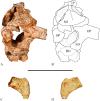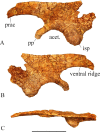A new basal ornithopod (Dinosauria: Ornithischia) from the Early Cretaceous of Texas
- PMID: 30860999
- PMCID: PMC6413910
- DOI: 10.1371/journal.pone.0207935
A new basal ornithopod (Dinosauria: Ornithischia) from the Early Cretaceous of Texas
Erratum in
-
Correction: A new basal ornithopod (Dinosauria: Ornithischia) from the Early Cretaceous of Texas.PLoS One. 2019 Aug 6;14(8):e0217232. doi: 10.1371/journal.pone.0217232. eCollection 2019. PLoS One. 2019. PMID: 31386670 Free PMC article.
Abstract
Material from a minimum of twenty-nine individuals of a new ornithopod, represented by nearly every skeletal element, was recovered from the Proctor Lake locality in the Twin Mountains Formation (Aptian) of north-central Texas. This material includes various ontogenetic stages, providing insight into the growth patterns of this species. The new ornithopod, Convolosaurus marri gen. et sp. nov., is recovered outside of Iguanodontia, but forms a clade with Iguanodontia exclusive of Hypsilophodon foxii. The presence and morphology of four premaxillary teeth along with a combination of both basal and derived characters distinguish this taxon from all other ornithopods. Basal characters present in C. marri including the presence of premaxillary teeth, the shape of the dentary teeth, and position of the pterygoid wing on the quadrate, whereas the presence of opisthocoelous cervical vertebrae, large proximal caudal neural spines, and curved maxillary tooth roots suggest C. marri is more derived than 80% of the basal neornithischians included in this analysis.
Conflict of interest statement
The authors have declared that no competing interests exist.
Figures






























References
-
- Winkler DA, Murry PA. Paleoecology and hypsilophodontid behavior at the Proctor Lake dinosaur locality (Early Cretaceous), Texas. Geological Society of America Special Paper. 1989;238: 55–61.
-
- Young K. Comanche Series (Cretaceous), south central Texas. Permian Basin Section, Society of Economic Paleontologists and Mineralogists. 1967;9–29.
-
- Winkler DA, Murry PA, Jacobs LL. Early Cretaceous (Comanchean) Vertebrates of Central Texas. Journal of Vertebrate Paleontology. 1990;10: 95–116.
-
- Jacobs LL, Winkler DA. Mammals, archosaurs, and the Early to Late Cretaceous transition in north-central Texas 1998;253–280 in Tomida Y, Flynn L.J., Jacobs L.L., editors. Advances in vertebrate paleontology and geochronology. National Science Museum, Tokyo.
-
- Tanrikulu S, Doyle JA, Delusina I. Early Cretaceous (Albian) spores and pollen from the Glen Rose Formation of Texas and their significance for correlation of the Potomac Group. Palynology. 2017;1–19.
Publication types
MeSH terms
LinkOut - more resources
Full Text Sources

